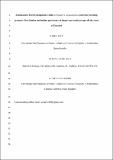Files in this item
Southeastern Pacific humpback whales (Megaptera novaeangliae) and their breeding grounds : distribution and habitat preference of singers and social groups off the coast of Ecuador
Item metadata
| dc.contributor.author | Oña, Javier | |
| dc.contributor.author | Garland, Ellen C. | |
| dc.contributor.author | Denkinger, Judith | |
| dc.date.accessioned | 2017-09-22T23:32:18Z | |
| dc.date.available | 2017-09-22T23:32:18Z | |
| dc.date.issued | 2017-01 | |
| dc.identifier | 245996106 | |
| dc.identifier | 4bc3e9e1-d2d0-4176-80bd-34b8d9d2870d | |
| dc.identifier | 84988566070 | |
| dc.identifier | 000391037300011 | |
| dc.identifier.citation | Oña , J , Garland , E C & Denkinger , J 2017 , ' Southeastern Pacific humpback whales ( Megaptera novaeangliae ) and their breeding grounds : distribution and habitat preference of singers and social groups off the coast of Ecuador ' , Marine Mammal Science , vol. 33 , no. 1 , pp. 219-235 . https://doi.org/10.1111/mms.12365 | en |
| dc.identifier.issn | 0824-0469 | |
| dc.identifier.other | ORCID: /0000-0002-8240-1267/work/49580221 | |
| dc.identifier.uri | https://hdl.handle.net/10023/11722 | |
| dc.description | The study was supported by a Rufford Small Grant, ECG. is currently funded by a Royal Society Newton International Fellowship; part of this work was completed while ECG was funded by a National Research Council (National Academy of Sciences) Postdoctoral Fellowship at the National Marine Mammal Laboratory, AFSC, NMFS, NOAA. | en |
| dc.description.abstract | Understanding the distribution, habitat preference and social structure of highly migratory species at important life history stages (e.g., breeding and calving) is essential for conservation efforts. We investigated the spatial distribution and habitat preference of humpback whale social groups and singers, in relation to depth categories (<20 m, 20–50 m, and >50 m) and substrate type (muddy and mixed) on a coastal southeastern Pacific breeding ground. One hundred and forty-three acoustic stations and 304 visual sightings were made at the breeding ground off the coast of Esmeraldas, Ecuador. Spatial autocorrelation analysis suggested singers were not randomly distributed, and Neu’s method and Monte Carlo simulations indicated that singers frequented depths of <20 m and mixed substrate. Singletons, and groups with a calf displayed a preference for shallower waters (0–20 m), while pairs and groups with a calf primarily inhabited mixed bottom substrates. In contrast, competitive groups showed no clear habitat preference and exhibited social segregation from other whales. Understanding the habitat preference and distribution of humpback whales on breeding and calving grounds vulnerable to anthropogenic disturbance provides important baseline information that should be incorporated into conservation efforts at a regional scale. | |
| dc.format.extent | 17 | |
| dc.format.extent | 983780 | |
| dc.language.iso | eng | |
| dc.relation.ispartof | Marine Mammal Science | en |
| dc.subject | Song | en |
| dc.subject | Spatial distribution | en |
| dc.subject | Habitat preference | en |
| dc.subject | Depth | en |
| dc.subject | Sea floor substrate | en |
| dc.subject | Humpback whale | en |
| dc.subject | Megaptera novaeangliae | en |
| dc.subject | Southeastern Pacific | en |
| dc.subject | GE Environmental Sciences | en |
| dc.subject | QH301 Biology | en |
| dc.subject | NDAS | en |
| dc.subject.lcc | GE | en |
| dc.subject.lcc | QH301 | en |
| dc.title | Southeastern Pacific humpback whales (Megaptera novaeangliae) and their breeding grounds : distribution and habitat preference of singers and social groups off the coast of Ecuador | en |
| dc.type | Journal article | en |
| dc.contributor.sponsor | The Royal Society | en |
| dc.contributor.institution | University of St Andrews. School of Biology | en |
| dc.contributor.institution | University of St Andrews. Centre for Social Learning & Cognitive Evolution | en |
| dc.contributor.institution | University of St Andrews. Centre for Biological Diversity | en |
| dc.identifier.doi | 10.1111/mms.12365 | |
| dc.description.status | Peer reviewed | en |
| dc.date.embargoedUntil | 2017-09-22 | |
| dc.identifier.grantnumber | NF140667 | en |
This item appears in the following Collection(s)
Items in the St Andrews Research Repository are protected by copyright, with all rights reserved, unless otherwise indicated.

